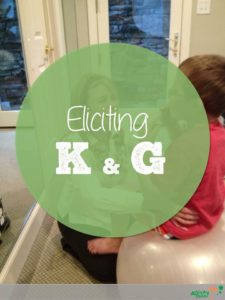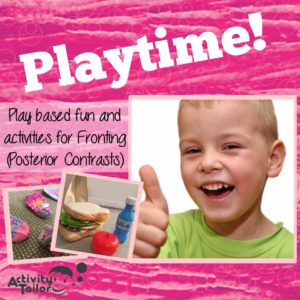The beginning of the school year is when I’m most likely to get a referral for a “fronter.” And, of course, it’s because those kids that come in needing help to elicit /k/ and /g/ sound so obviously in need of speech therapy. The good news is, once remeditated, it makes a big impact and my experience has been that it often happens fairly quickly. The key is to elicit anything you can in the back of the mouth and start generalization as soon as possible.
The trick that works best for me involves the physioball. I use it in two ways. The first is to gently bounce the child on top and play with sounds we can make with an open mouth that are towards the back. Often this starts with a back vowel sound, maybe shooting for a vowel and a kind of soft /g/ sound.
Next, I lay them back over the ball (be sure there are no physical limitations that would prohibit this movement) and see if we can get something a little more voluntary. If I can’t elicit a /k/ or /g/, I’ll settle for an approximation that sounds like a cough. I know a lot of therapists do a variation of this by having kiddos lay on the floor. I haven’t found that positioning to be as helpful as bending backwards which allows them to maintain a more open mouth position. Laying on the floor just seems to bunch everything up or doesn’t have much impact at all.
Then we cycle through these activities a couple of times. The rest of the session we play with very intentionally chosen toys. I will continue to probe and have them make attempts at a back sound, but often the purpose is to have them start to listen to the sounds and understand where they come from within our mouth. Often I use my hand on my throat to give them a visual cue. Most often, my little guys take about three sessions before I hear them start to make a back sound on their own.
Sometimes I have more success if I choose words that have a /k/ sound both at the beginning and end of the word like: cook, cake or coke. I am extremely careful not to include words that involve a front sound, particularly /t/ or /d/ so “cat” activities are out, at least to start.
I send home listening lists almost immediately and, once the child is able to produce a decent and consistent approximation of what I’m looking for, I send home a pacing strip with pictured words for parents to help with at home.
Looking to save some time? My newest Playtime ebook includes descriptions of lots of activities to elicit back sounds using toys and materials you already have. My youngest students have no idea we’re “working” because our sessions involve play! Also included are letters to parents, listening lists and pacing boards. You can check out the full description for Playtime for Fronting and Posterior Contrasts here.
The series also includes Playtime for S Clusters (Blends) and Playtime for Final Consonant Deletion.
Love play based therapy sessions and want to learn more? Join me for Putting Play to Work, a five start webinar loaded with practical ideas for speech and language!







